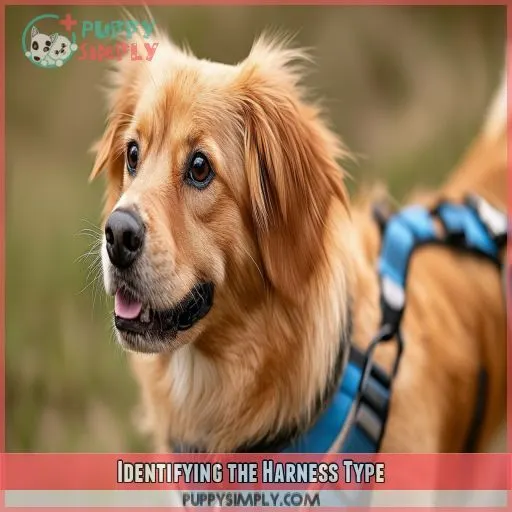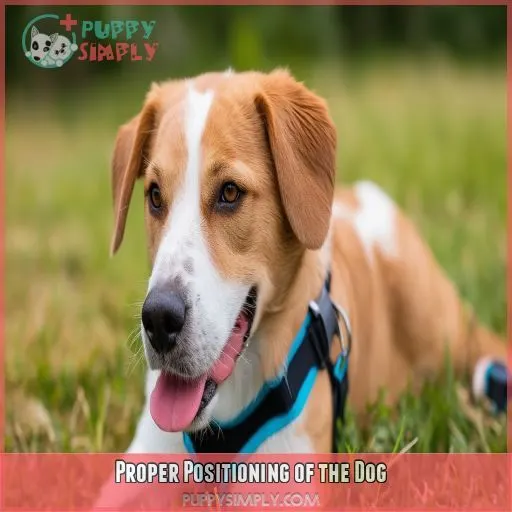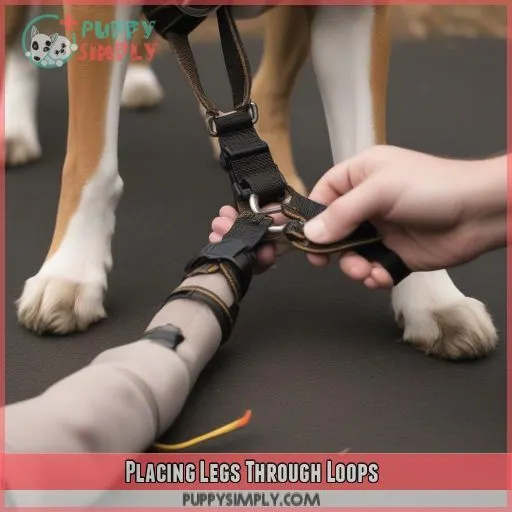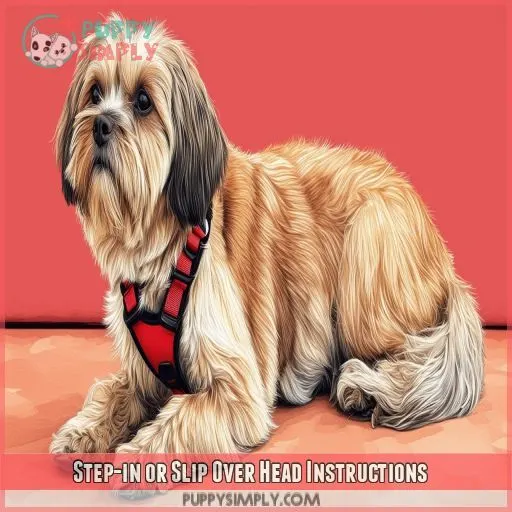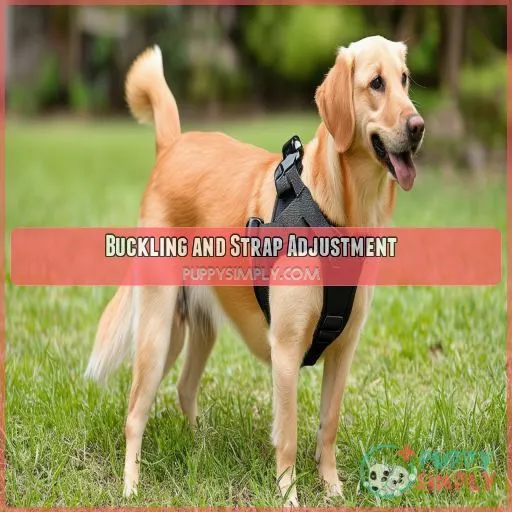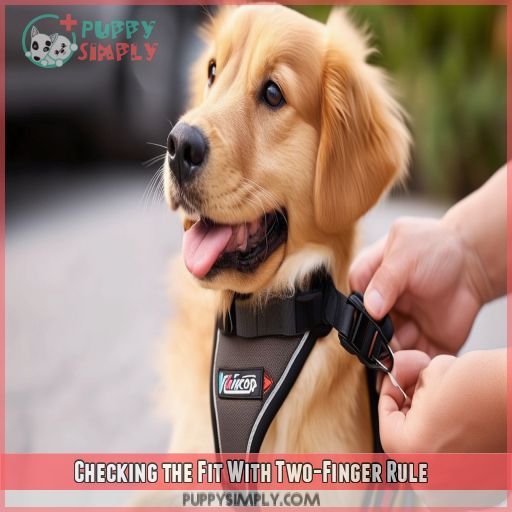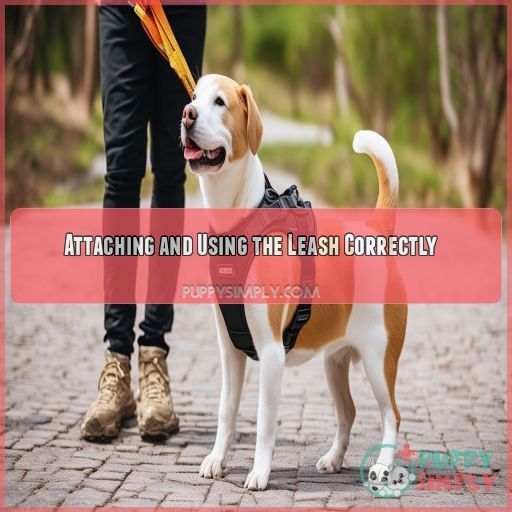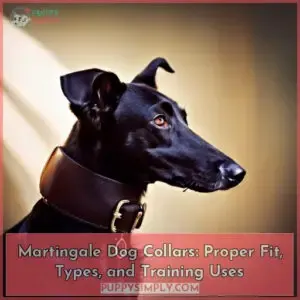This site is supported by our readers. We may earn a commission, at no cost to you, if you purchase through links.
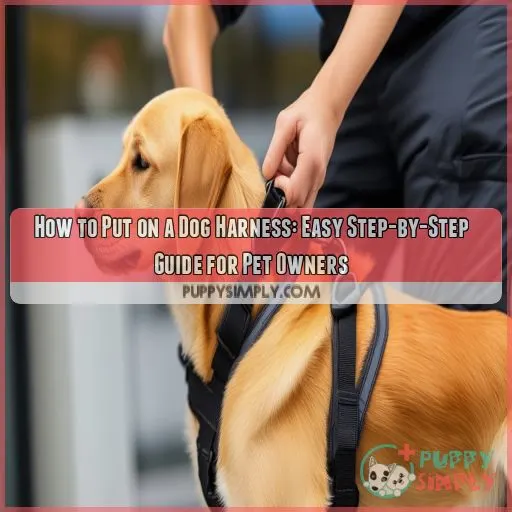 Thankfully, learning to install a dog harness can turn walks from mayhem to mastery. Either way, whether one has a feisty pup or an older dog, knowing the steps is essential in ensuring safety and comfort.
Thankfully, learning to install a dog harness can turn walks from mayhem to mastery. Either way, whether one has a feisty pup or an older dog, knowing the steps is essential in ensuring safety and comfort.
This step-by-step guide will help make it easy for both you and your dog. It covers everything from identifying types of harnesses to perfecting any fit.
Let us make each walk a pleasure and safe for you and your pet.
Table Of Contents
- Key Takeaways
- How to Put on a Dog Harness?
- Identifying the Harness Type
- Proper Positioning of the Dog
- Guiding Dog’s Head Through Opening
- Placing Legs Through Loops
- Step-in or Slip Over Head Instructions
- Buckling and Strap Adjustment
- Checking the Fit With Two-Finger Rule
- Attaching and Using the Leash Correctly
- Rewarding Positive Behavior
- Frequently Asked Questions (FAQs)
- How to put on a dog harness correctly?
- How to put on a dog harness for easy walk?
- Why won’t my dog put a harness on?
- How do you put a pull harness on a dog?
- How to select the right harness size?
- Can harnesses prevent dogs from escaping?
- Are no-pull harnesses suitable for all dogs?
- Do harnesses cause any injuries or discomfort?
- How to maintain and clean a dog harness?
- Conclusion
Key Takeaways
- Choosing the right harness is like finding Cinderella’s glass slipper – it’s got to be just right! Measure your pup’s chest and neck, and don’t forget to factor in their personality. A puller might need a front-clip harness, while a laid-back pooch could rock a simple overhead style.
- Getting your furry friend into position is half the battle. Imagine you’re a dog whisperer – use soothing words, treats, and maybe even a little belly rub to keep them calm. It’s like trying to put socks on a toddler, but with more fur and slobber!
- The two-finger rule is your new best friend. If you can slip two fingers under the straps, you’ve hit the sweet spot – snug enough to prevent Houdini-like escapes, but comfy enough for your pup to strut their stuff.
- Positive reinforcement is the name of the game. Treats, praise, and maybe even a victory dance will help your dog associate the harness with good times. Before you know it, they’ll be wagging their tail at the mere sight of it, ready for their next adventure!
How to Put on a Dog Harness?
There is no need to become frustrated while putting on a dog harness. First, know what kind of harness you are dealing with: overhead, step-in, or custom.
Position your pup calmly facing you. Guide your dog’s head through the opening with overhead harnesses, then his legs through the loops. Step-in harnesses require a pup to place his paws in the triangles.
Adjust straps for a snug fit, allowing two fingers width underneath. Place the D-ring right down the center of your dog’s back, then clip on the leash.
There you have it—onto the streets! Let’s delve into more details to make those walks a real breeze.
Identifying the Harness Type
To begin, you need to identify the type of harness that suits your dog’s needs. There are various options, including the overhead harness, step-in harness, and custom-made harnesses with personalized designs. Look for different harness materials, ensuring they’re durable and comfortable. When selecting the proper size, measure your dog’s chest and neck, and choose one that fits snugly. Reflective strips are an excellent addition for safety during nighttime walks.
Assessing your dog’s behavior helps too; a dog that pulls might benefit from a front-clip or no-pull harness. Remember, each type of dog harness has specific steps for putting on, so knowing what you’re working with will streamline the process and keep your furry friend secure.
Proper Positioning of the Dog
After the identification of the harness type, the next thing will be to position your dog correctly for smooth application. Firstly, ensure that your dog is calm. Use soothing words and gentle petting. Sometimes due to excited energy, some dogs could make positioning difficult; try to reward them with treats in order to distract them from what you’re doing.
If your dog is bigger in size, kneel beside them for better control. Make sure that the dog faces you, standing or sitting steady depending on their comfort. Confirm that the harness isn’t tangled and each loop can easily be recognized. Check the size and adjust the straps for an initial fit. This is a pretty important preparatory measure both for comfort and control during the process. By addressing these elements, you make the experience more comfortable for both you and your dog.
Guiding Dog’s Head Through Opening
Bring your dog’s head through the head opening in the harness. Start with your pup calm and secure—possibly even using a treat or soft words to help keep him so. Depending on the type of harness, this is going to be either an overhead slip or step-in design—take special note of the proper orientation to allow ease of entry.
Slowly and carefully guide your dog’s head through the opening, keeping in mind his comfort and safety.
Ensure proper harness positioning: D-ring or attachment point centered on his back.
- The sizing should be adjusted according to the requirement that it’s tightly fitted but comfortable enough to admit two fingers under the straps easily.
Very soon, with patience and positive reinforcement, he’ll begin to associate the harness with good things.
Placing Legs Through Loops
After selecting the right design of the dog harness and having your dog positioned calmly, focus on leg positioning and strap placing.
Guide the front legs through the loops. For those harnesses with leg holes, lift your paws one by one gently. Never twist the straps.
The importance of proper leg positioning is to give comfort when sitting in a harness. Different harnesses will have their different kinds of leg placing, but most remains the same with two principles based: no chafing, snug fit.
Correct fitting of the leg loops is important, especially in active dogs, because it has implications for comfort and function to facilitate training and safety when walking.
A well-fitting harness enhances experiences whether attaching a dog leash for a stroll or using as an aid in training where both safety and comfort are priorities.
Step-in or Slip Over Head Instructions
This is, therefore, particularly crucial for step-in or slip-over-head harnesses to ensure the comfort and safety of your dog. For step-in harnesses, lay it out flat with the buckles on top and then set your dog’s front feet in the small triangles. If slip-over-head harnesses are the choice, orient the harness so the D-ring or label faces the back, and then stretch it over the head of your dog.
Remember these important points :
- Select the Perfect Style which goes with your pet’s behavior.
- Choose harness materials that are robust and comfortable.
• Make sure that you follow the sizing guide to find your right fit.
- Reflective features good for night-time strolls.
Proper fit is critically important; incorrect placement can cause discomfort or the loss of control for the dog during a walk.
Buckling and Strap Adjustment
Now that your dog’s head and legs are in place, you can fasten the harness and adjust the straps. Depending on your kind of harness, these will either clip together on your dog’s back or attach with a belly strap underneath. Take your time, and make sure everything fits snugly yet cozily around him.
| Materials on Selection | Clip Location: Back vs Front | Adjustable Features | Comfort vs Control |
|---|---|---|---|
| Choose high-quality, hardwearing materials that won’t chafe or irritate your pup’s skin. | Back-clip harnesses allow for a more relaxed walking experience, while the front-clip designs will give you greater control over pulling behaviors. | Adjustable straps and buckles help achieve that perfect fit as your dog grows. | Balance your dog’s comfort with the level of control you need for their training level and walking habits. |
Make sure everything is securely in place to bring out the best in your dog’s harness. Adjust the straps properly, then clip on the leash, and you’re good to go.
Checking the Fit With Two-Finger Rule
You’ve strapped up the harness—but now it’s important to make sure it’s fitting right.
One easy way to check: slide two fingers under each strap. If it isn’t too tight and yet not too loose, then you’re good. If the harness is too loose, your dog might wriggle free. If it’s too tight, there could be discomfort or chafing.
What’s more, test if the harness has a pretty easy time moving around, which still shows it isn’t secure enough. Check the fit at different points: around the neck and chest. These will help you adjust where necessary to ensure that everything is perfect.
A snug harness allows your dog to move about while providing a great sense of security and control. Once the fit is perfect, then you can confidently move on knowing your dog is comfortable and secure.
Attaching and Using the Leash Correctly
Properly attaching the leash keeps your pet safe and under control when strolling. Begin with the identification of the D-ring of the harness where you’ll attach the leash; for standard harnesses, locate that ring on the back.
Follow these steps:
- Clip in the Leash: Take the leash clip and attach it to the D-ring, making sure that it’s secure.
- Check Tension on Leash: A comfortable tension to the leash doesn’t permit pulling, yet provides support for better control.
- Leash length adjustment: Use a leash that allows for adjustment in its length and is fabricated with materials appropriate to the size and strength of your dog.
Go for strong materials such as nylon or leather. Avoid retractable leashes because they may provide uneven tension. Store your leash well after use to keep it in good condition.
Rewarding Positive Behavior
As you take your pup through the harness-donning process, be sure to give plenty of praise and tasty treats. These positive reinforcements will help your canine companion figure that the harness is really related to something enjoyable, hence making the experience far much smoother in the long run.
| Type of Reward | Purpose | Timing |
|---|---|---|
| Treats | Motivate good behavior | Immediately after successful steps |
| Verbal Praise | Encourage and build confidence | Throughout |
With patience and consistent positive reinforcement, your dog will soon learn to eagerly anticipate the arrival of their harness. This will make your walks and adventures together a breeze!
Frequently Asked Questions (FAQs)
How to put on a dog harness correctly?
Choose the right harness type for your dog. Slip it over their head or guide their legs through openings. Adjust straps for a snug fit, allowing two fingers underneath. Secure buckles and attach the leash. Reward your pup!
How to put on a dog harness for easy walk?
Great Caesar’s ghost! For an easy walk, lay the harness flat, guide your pup’s paws through the loops, and fasten securely. Adjust for a snug fit, allowing two fingers’ width. Attach the leash to the designated clip.
Why won’t my dog put a harness on?
Your dog might be resistant because he’s scared, uncomfortable, or has formed an avoidance. Gradually introduce the harness to him – with treats and praise. Make sure it’s not going to hurt him by having a proper fit. So once again, patience is called for, along with positive reinforcement.
How do you put a pull harness on a dog?
You’ll need to slip the harness over your dog’s head, guide their legs through the loops, and secure the buckles. Adjust for a snug fit, ensuring you can slip two fingers under the straps. Attach the leash to the front clip.
How to select the right harness size?
Did you know 40% of dog owners use harnesses? To select the right size, measure your dog’s chest and neck. Add 2 inches to chest and 1 inch to neck measurements. Choose a harness that’s snug but allows two fingers underneath.
Can harnesses prevent dogs from escaping?
Finally, a well-fitted harness can prevent the dog from getting away. Harnesses are considered safer compared to collars because they share pressure. One should be sure that it’s fitted tight, leaving a space for two fingers under the straps; regular adjustments mean safety is guaranteed.
Are no-pull harnesses suitable for all dogs?
No-pull harnesses aren’t one-size-fits-all. While effective for many dogs, they may not suit every pup. Consider your dog’s size, behavior, and comfort level. For some, training or alternative methods might be more appropriate. Always consult a professional for personalized advice.
Do harnesses cause any injuries or discomfort?
Much like a well-fitted shoe, harnesses shouldn’t cause injuries or discomfort. You want to know you have a proper fit and adjustment. Occasional chafing may occur; however, that’s very rare with any good harness. Checks and adjustments are regularly done to avoid any potential problems.
How to maintain and clean a dog harness?
Regularly brush off dirt and spot clean your dog’s harness with mild soap and water. For deep cleaning, hand wash in warm, soapy water, rinse thoroughly, and air dry. Inspect for wear and tear during cleaning.
Conclusion
Mastering putting on a dog harness will make those dreaded dog walks much more peaceful. You have learned harness type identification, correct positioning of your dog, and how to adjust for a perfect fit.
Follow these steps, and you’re all set for an interesting yet safe walk with your furry companion. Now, grab that harness, leash up, and hit your next adventure with confidence!
- akc.org
- m.petmd.com
- allthingsdogs.com

